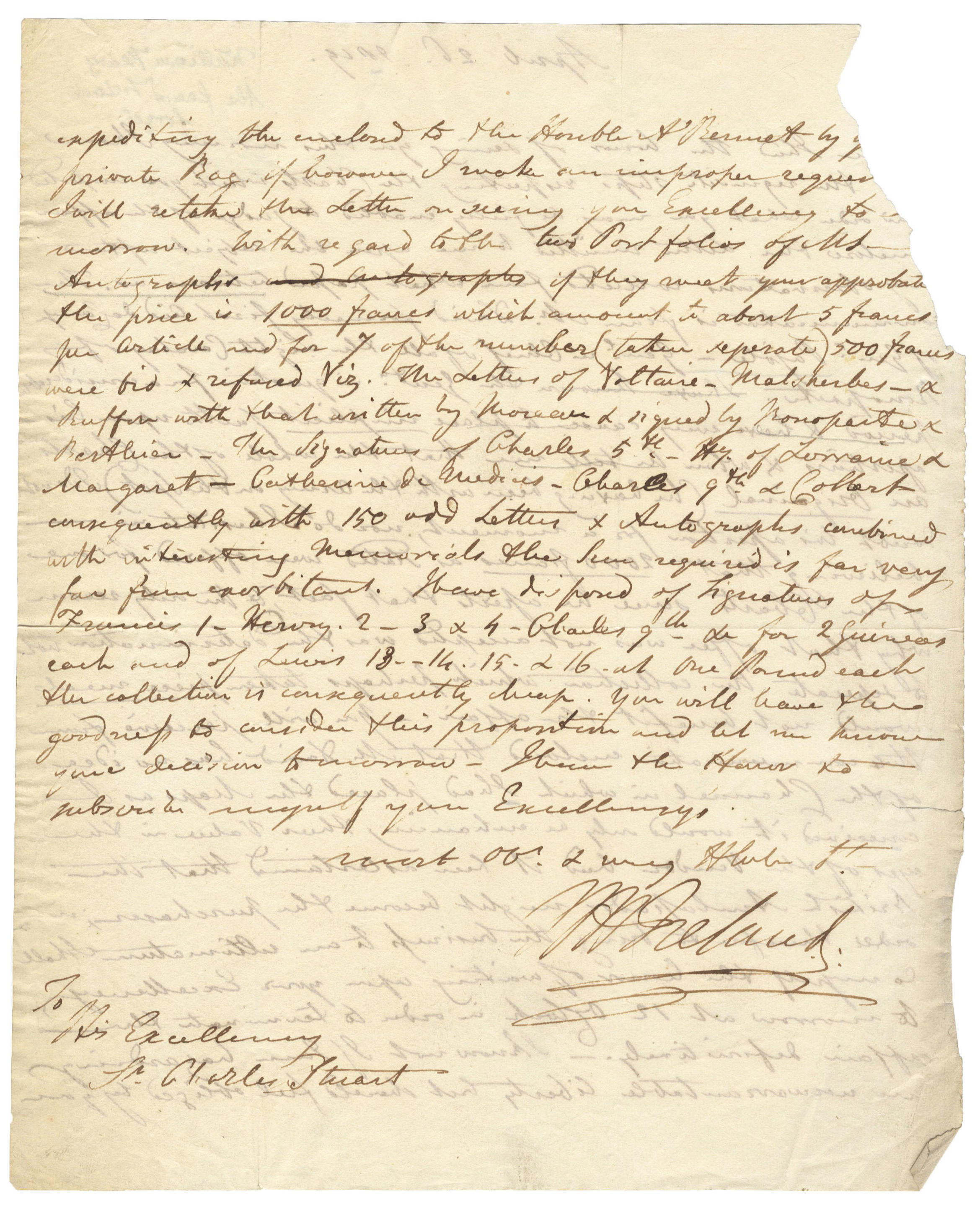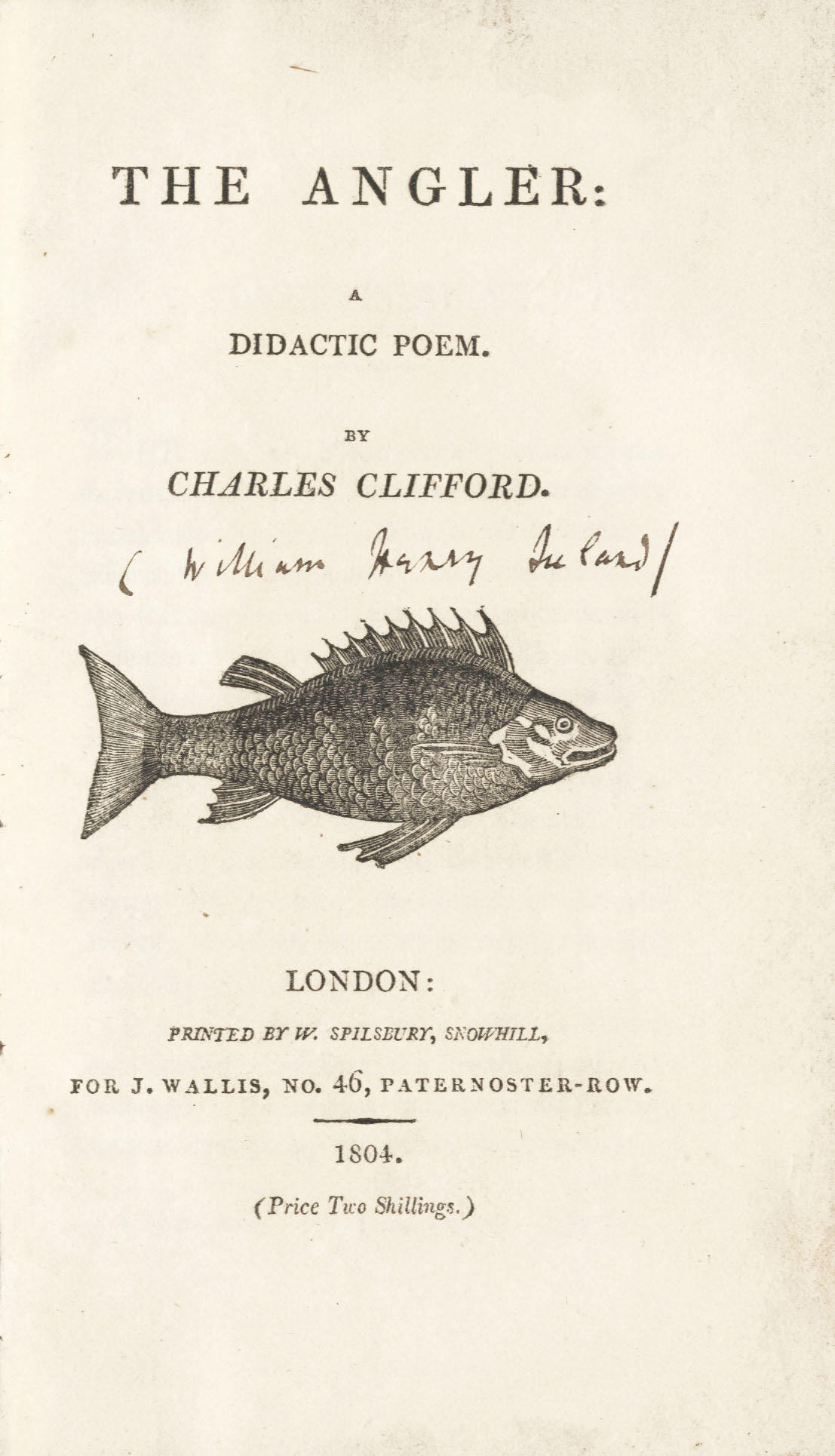IRELAND, William Henry (1775-1835). Autograph manuscript of his Confessions , [?London: c.1805], including almost the complete text and index, heavily revised for publication by Ireland and at least one other, and marked for printing (see below), written on paper watermarked 1801 and 1803 in brown ink, approx. 196 pages, 2° (315 x 198mm) and 13 insertions (lacking the text on pp. 1-23, 287-95, and 300-17 of the printed edition). The printed edition contained two illustrations; the manuscript contains a drawing of the 'Shakespeare' seal only (frontispiece of the printed edition). Mid 19th-century red morocco, gilt spine (extremities very lightly scuffed). IRELAND'S AUTOGRAPH MANUSCRIPT OF HIS CONFESSIONS (published London: 1805), in which he details fully (if not always accurately) his Shakespeare and other forgeries. After the documents had been proven to be forgeries, William Henry Ireland published a pamphlet entitled An authentic account of the Shakesperian MSS (1796) in which he confessed himself their sole author in an attempt to clear the name of his father, Samuel. Samuel Ireland had been an enthusiastic supporter (and owner) of his son's "discoveries", promoting them proudly and widely, and so was accused -- falsely -- of complicity in their creation. However, he was unable to come to terms with the deep deception practiced by his son and consequently in his own error in accepting them as genuine, so that he continued to proclaim their authenticity until his dying day, although the rupture between father and son after the debacle was complete. William Henry Ireland wrote his Confessions to take advantage of continuing interest in the forgeries, shown by prices fetched by copies of his 1796 pamphlet, An authentic account , by then out-of-print. The present manuscript represents a working draft of the Confessions in its final stages before publication. The manuscript in an earlier form has been dismantled and reassembled section by section into its final sequence by mounting them onto leaves. In this form Ireland continued to work on the manuscript, and it shows significant amendments and additions. That the manuscript was used for preparing the printed edition, if it was not the actual printer's copy, is witnessed by the regular corrections to spelling and punctuation and indications of paragraph breaks, and by the occasional instruction on typeface written by an editor and followed in the printed edition: longprimer small capitals are specified in at least three instances (printed pp. 203, 214 and 215), and black letter is specified in one. The same editor also made substantive alterations to the text, principally towards the end. Furthermore, pagination has been written over the text at nine points (accompanied by a letter, D-N), and in each case it corresponds exactly to page breaks in the printed text and thus represents either casting off (although more regular evidence of casting off is not apparent) or distribution of copy between presses. Further illustrations were apparently intended for they are allowed for in the manuscript but not supplied: 'Real and fictitious autographs of Lord Southampton' [p.63], 'Representation of the Lock of Hair' [p.64],'Real and fabricated signatures of John Heminge' [p.67], and Candolle's spurious signature [p.78].
IRELAND, William Henry (1775-1835). Autograph manuscript of his Confessions , [?London: c.1805], including almost the complete text and index, heavily revised for publication by Ireland and at least one other, and marked for printing (see below), written on paper watermarked 1801 and 1803 in brown ink, approx. 196 pages, 2° (315 x 198mm) and 13 insertions (lacking the text on pp. 1-23, 287-95, and 300-17 of the printed edition). The printed edition contained two illustrations; the manuscript contains a drawing of the 'Shakespeare' seal only (frontispiece of the printed edition). Mid 19th-century red morocco, gilt spine (extremities very lightly scuffed). IRELAND'S AUTOGRAPH MANUSCRIPT OF HIS CONFESSIONS (published London: 1805), in which he details fully (if not always accurately) his Shakespeare and other forgeries. After the documents had been proven to be forgeries, William Henry Ireland published a pamphlet entitled An authentic account of the Shakesperian MSS (1796) in which he confessed himself their sole author in an attempt to clear the name of his father, Samuel. Samuel Ireland had been an enthusiastic supporter (and owner) of his son's "discoveries", promoting them proudly and widely, and so was accused -- falsely -- of complicity in their creation. However, he was unable to come to terms with the deep deception practiced by his son and consequently in his own error in accepting them as genuine, so that he continued to proclaim their authenticity until his dying day, although the rupture between father and son after the debacle was complete. William Henry Ireland wrote his Confessions to take advantage of continuing interest in the forgeries, shown by prices fetched by copies of his 1796 pamphlet, An authentic account , by then out-of-print. The present manuscript represents a working draft of the Confessions in its final stages before publication. The manuscript in an earlier form has been dismantled and reassembled section by section into its final sequence by mounting them onto leaves. In this form Ireland continued to work on the manuscript, and it shows significant amendments and additions. That the manuscript was used for preparing the printed edition, if it was not the actual printer's copy, is witnessed by the regular corrections to spelling and punctuation and indications of paragraph breaks, and by the occasional instruction on typeface written by an editor and followed in the printed edition: longprimer small capitals are specified in at least three instances (printed pp. 203, 214 and 215), and black letter is specified in one. The same editor also made substantive alterations to the text, principally towards the end. Furthermore, pagination has been written over the text at nine points (accompanied by a letter, D-N), and in each case it corresponds exactly to page breaks in the printed text and thus represents either casting off (although more regular evidence of casting off is not apparent) or distribution of copy between presses. Further illustrations were apparently intended for they are allowed for in the manuscript but not supplied: 'Real and fictitious autographs of Lord Southampton' [p.63], 'Representation of the Lock of Hair' [p.64],'Real and fabricated signatures of John Heminge' [p.67], and Candolle's spurious signature [p.78].

.jpg?w=400)












Testen Sie LotSearch und seine Premium-Features 7 Tage - ohne Kosten!
Lassen Sie sich automatisch über neue Objekte in kommenden Auktionen benachrichtigen.
Suchauftrag anlegen